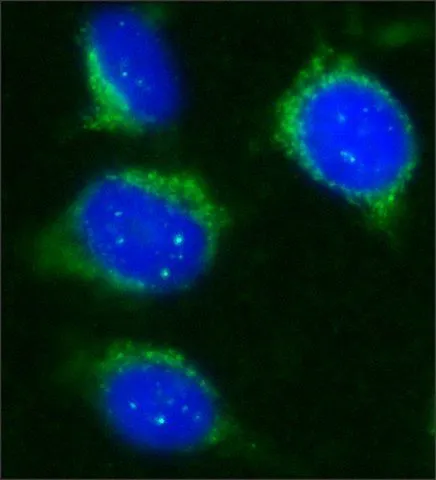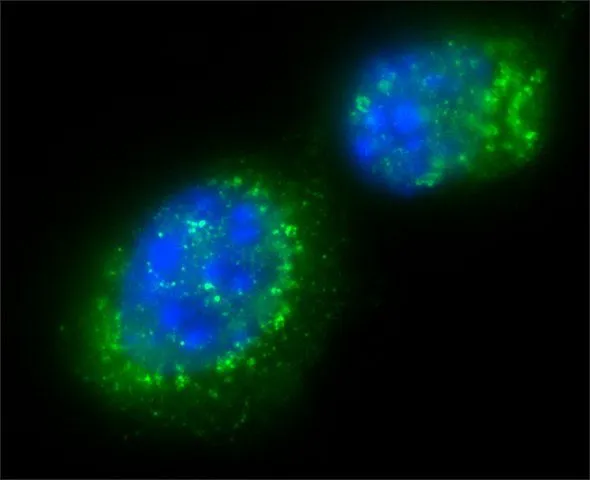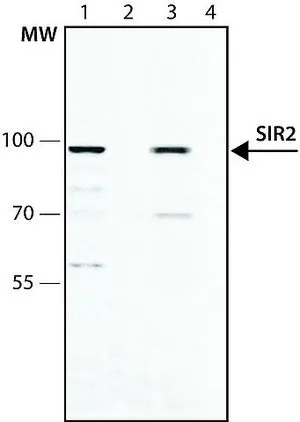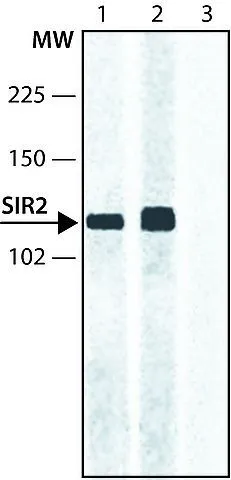
ICC/IF analysis of HeLa cells using GTX12193 SIRT2 antibody at 20 microg/mL(green) with DAPI(blue).
SIRT2 antibody
GTX12193
ApplicationsImmunoFluorescence, Western Blot, ImmunoCytoChemistry
Product group Antibodies
ReactivityHuman, Mouse
TargetSirt2
Overview
- SupplierGeneTex
- Product NameSIRT2 antibody
- Delivery Days Customer9
- Antibody SpecificityAnti-Sir2 polyclonal antibody specifically recognizes mouse Sir2 (AS-16). Staining of the Sir2 band is specifically inhibited by the immunizing peptide.
- Application Supplier NoteWB: 1:2,000. ICC/IF: 1:50. *Optimal dilutions/concentrations should be determined by the researcher.Not tested in other applications.
- ApplicationsImmunoFluorescence, Western Blot, ImmunoCytoChemistry
- CertificationResearch Use Only
- ClonalityPolyclonal
- ConjugateUnconjugated
- Gene ID64383
- Target nameSirt2
- Target descriptionsirtuin 2
- Target synonyms5730427M03Rik; mSIR2L2; NAD-dependent deacetylase sirtuin-2; NAD-dependent protein deacetylase sirtuin-2; regulatory protein SIR2 homolog 2; S; SI; silent mating type information regulation 2, (S.cerevisiae, homolog)-like; sirtuin 2; Sir2l; SIR2L2; SIR2-like protein 2
- HostRabbit
- IsotypeIgG
- Protein IDQ8VDQ8
- Protein NameNAD-dependent protein deacetylase sirtuin-2
- Scientific DescriptionSIR2, one of the silent information regulator genes, encodes a protein that promotes a compact chromatin structure, thereby preventing or silencing gene transcription at selected loci. SIR2 belongs to a family of proteins that is found in organisms ranging from bacteria to complex eukaryotes. Members of this family contain a 250 amino acid core domain that shares about 25-60% sequence identity. Silencing occurs as a series of events initiated by formation of Sir complexes (Sir2, Sir3, Sir4). The complexes are recruited to their chromosome targets via interactions with DNA-binding proteins, followed by deacetylation of histones H3 and H4. A final step required for telomeric silencing is binding of the complex to the deacetylated histones and recruitment of the telosome to the nuclear periphery. Sir2 protein is an NAD-dependent histone deacetylase, an enzyme that removes acetyl groups from lysine residues of histone proteins and possibly other substrates. Sir2 transfers acetyl groups from its protein substrates to ADP-ribose and synthesizes o-acetyl-ADP-ribose. Through histone deacetylation, Sir2 may silence chromatin. The maintenance or silencing of chromatin may be at the center of processes leading to aging of cells and development of cancer.
- ReactivityHuman, Mouse
- Storage Instruction-20°C or -80°C,2°C to 8°C
- UNSPSC12352203



